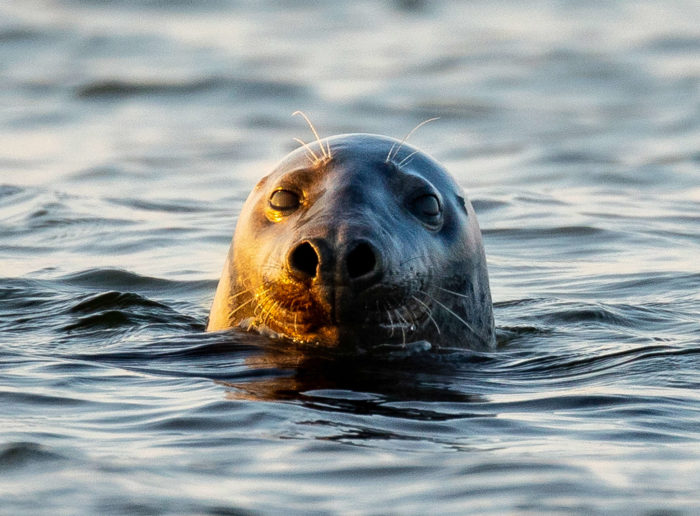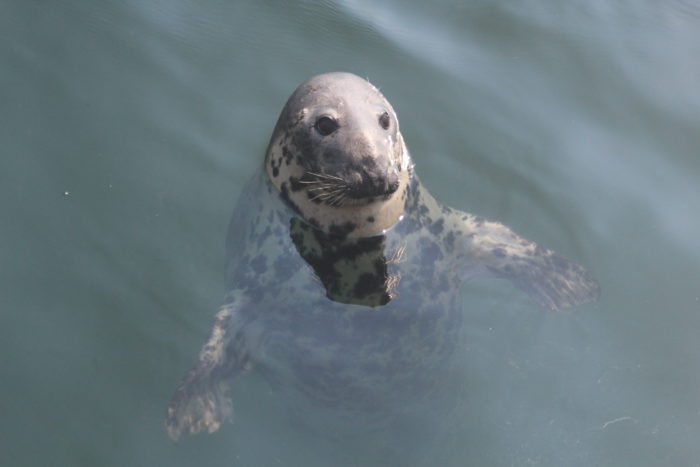
Sea Wonder: Gray Seal

A gray seal pokes its head out of the water in Stellwagen Bank National Marine Sanctuary. Photo credit: Matt McIntosh/NOAA
Gray seals (Halichoerus grypus) are part of the phocid or true seal family. Interestingly, despite the name, their coats are not always completely gray in color! They are common along the rocky shores of New England, Canada, the UK, and Scandinavia. These seals spend quite a bit of time at rest on sandbars, rocky shorelines, islands, and ice shelves, but don’t mistake them for being lazy – these athletic swimmers can dive nearly 200 feet below the ocean’s surface and hold their breath for more than an hour.
DESCRIPTION
Seals are well adapted for their aquatic environment. Their bodies have a streamlined shape resembling a torpedo, which is skinniest at the head and the rear flippers, which reduces drag and makes them hydrodynamic when swimming. Their musculature is strong but flexible, allowing them to quickly bend and turn in the water to catch prey or avoid predators.
As part of the true seal family, gray seals have two short front flippers tipped with five claws each. When they need to steer or slow themselves down in the water or swipe at prey, they will move and extend their flippers, but otherwise they remain tucked close to the seal’s body (unless they have an itch to scratch). These animals don’t have ear flaps and cannot rotate their flippers underneath their body, so they have to inchworm to get about on land, which may seem slow and clumsy, but they can outpace a human on land over short distances!
Gray seals are covered in dense fur and have thick whiskers above their large eyes and near their noses, which they use like antennae to detect movements in the water. Mature gray seals molt and change their fur colors and patterns in the warmer summer months, but females tend to have silver-gray or brown fur, while males tend to be dark gray or brown with silver-gray spots. Beneath their fur is a dense layer of fatty blubber, which insulates them from the cold waters they inhabit. When fully grown, gray seals can reach lengths of between 7.5 and 10 feet and weigh between 550 and 880 pounds. Males are often larger than females, which is known as sexual dimorphism. Males also have distinctively arched Roman noses while females have more delicate facial features. In fact, males have such a unique nose that the species’ Latin name means “hook-nosed pig of the sea”!
DIET & HABITAT
Gray seals need to eat anywhere from four to six percent of their bodyweight in food each day depending on their individual needs, time of year, and types of food available. They are carnivores that use their excellent eyesight, hearing, and vibration-detecting whiskers to locate prey, and they use their quick swimming abilities and flexibility to grab their targets with their sharp teeth before shredding them or swallowing them whole. They are opportunistic feeders, meaning they will eat whatever is available and easiest to catch, which includes fatty fish, eels, squid, crustaceans, and, on very rare occasions, sea birds. These seals often hunt in small groups, which makes food easier to catch, especially species that school or gather in groups. Larger sharks and orcas are the gray seal’s natural predators.
Gray seals live in three distinct populations along the coasts of the Atlantic Ocean and the Baltic Sea, and they are commonly seen in Stellwagen Bank National Marine Sanctuary. They gather on rocky beaches, sandbars, ice sheets, or small islands when they are not in the water foraging. They gather in larger groups during mating season, which occurs in the warmer months of the year, and are otherwise pretty solitary (but sometimes gather in small groups or large aggregations). Gray seals are well-equipped for navigating the ocean and can stay out to sea for days at a time when hunting.
LIFE HISTORY
Gray seal pups are born after a pregnancy lasting about 11 months, which includes a three-month delay between fertilization and implantation of the egg. Mating and pupping season usually occurs during the warmer months when waters are warmer and food is plentiful, though seals do not eat during mating, pupping, or molting season. During this time, gray seals gather along the coast in large aggregations and can be quite vocal and gregarious, which is drastically different from their seemingly reserved and quiet nature seen during the remainder of the year. Their whiskers also help them practice tactile communication with each other. Males will challenge each other with hissing and growling to establish dominance, and females use vocalizations and body language cues to indicate whether they are receptive to mating. Larger males can mate with as many as 10 females per season while younger or smaller males may not mate at all.
Pregnant females delivering pups from the previous year gather on land in groups called rookeries, where they give birth and nurse their young for only a few weeks before the pups are fully weaned, learn to hunt and eat solids, and become fully independent. All gray seals being their migrations immediately after mating season and return to their birth sites only when they are sexually mature.
Gray seal pups are born with thick white fur known as lanugo, which traps heat from sunlight and helps keep the growing pups warm. Pups weigh about 35 pounds at birth and in the first three weeks of life, the fatty milk females produce allows the pups to gain up to three pounds of blubber each day. Pups are quite vocal and use sound, visual cues, and smell to identify their mothers during the nursing period. They are considered fully grown at around three years old, and gray seals can live to be a maximum of 25 to 35 years old.
THREATS & CONSERVATION
Like all other marine mammals in the United States, gray seals receive protections in all U.S. waters under the Marine Mammal Protection Act. Gray seals are considered a species of least concern by the IUCN Red List and do not seem to be at risk of significant population-level declines.
Gray seals do get tangled in fishing nets, which they sometimes try to steal fish from, and are increasingly threatened by boat strikes, other fishing gear, and marine debris. When seals are trapped by gear, seals often drown because they are weighed down and can’t get to the surface to breathe. Pollutants are also a threat gray seals face because some pollutants are stored in the animals’ blubber layers, threatening their immune and reproductive systems, and being passed on to pups when females convert fat to milk. Physical pollution like oil spills can also harm gray seals if it comes in contact with their dense fur layer, as it prevents the animals from repelling water and can make swimming and thermoregulation nearly impossible.
Gray seals are easy to view in the wild, which also puts them at greater risk of harassment by humans. Feeding, approaching, or attempting to do either to a gray seal is both harmful and illegal. Seals spend quite a bit of time resting on land and well-intentioned beachgoers sometimes mistake napping for illness or injury. This sometimes leads pups to be separated from their mothers too early or injuries to the seal or people and their pets that get too close. If you ever find yourself in this situation, contact NOAA’s Marine Mammal Stranding and Entanglement Response Network, making note of the animal’s location, condition, and any other details that may be helpful. Once reported, a team of trained volunteers will assess the situation and respond if necessary.

Photo credit: Anne Smrcina
